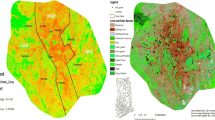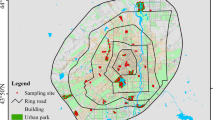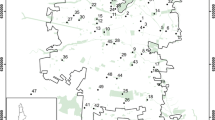Abstract
Parks play an important role in sustaining the urban ecosystem owing to their plant diversity. Therefore, identification of plant composition in parks has contributed to better their planning and management. In this study, woody plant species in a total of 53 parks of the selected 15 neighborhoods in Burdur were explored, plant diversity indexes were calculated and correlations of the attributes of plants and parks with the socioeconomic status of the neighborhoods were analyzed. A total of 36 family, 85 genus and 127 species were recorded. Neighborhood parks had more than 50% exotic species. Neighborhood parks with higher socioeconomic status had higher numbers of species and invasive species. The pattern from the similarity analysis supported the correlation between the number of species and socioeconomic status. Park area had a positive and strong correlation with the attributes and diversity indexes of plant. Moreover, distance from the park to the city center had negative and strong correlation with plant attributes and Shannon diversity and Margalef’s Richness Indexes. Albeit the large number of exotic species in neighborhood parks, the native species in the establishment of neighborhood parks should be actually preferred in terms of adaptation to the climate change. Furthermore, park management should consider the opinions of the people in the neighborhood instead of just making their own decisions in order to increase the park use. Further studies are needed including a broader range of socioeconomic variables to draw deeper conclusions about drivers of plant diversity of neighborhood parks.





Similar content being viewed by others
Data Availability
All data is currently available by request from the corresponding author.
Code Availability
Not applicable.
References
Abendroth S, Kowarik I, Müller N, von der Lippe M (2012) The green colonial heritage: Woody plants in parks of Bandung, Indonesia. Landsc Urban Plan 106:12–22. https://doi.org/10.1016/j.landurbplan.2011.12.006
Akkemik U (2018) Türkiye’nin doğal-egzotik ağaç ve çalıları. T. C. Orman ve Su. İşleri Bakanlığı Orman Genel Müdürlüğü, Ankara
Anderson PML, Potgieter LJ, Chan L, Cilliers SS, Nagendra H (2021) Urban plant diversity: understanding informing processes and emerging trends. In: Shackleton CM, Cilliers SS, Davoren E, du Toit MJ (eds) Urban ecology in the Global South. Springer, Cham, pp 145–168. https://doi.org/10.1007/978-3-030-67650-6_6
Anonymous (2012) Türkiye orman varlığı. T.C. Orman ve Su Işleri Bakanlığı. Orman Genel Müdürlüğü, Ankara
Anonymous (2013) İl çevre durum raporu. T.C. Burdur Valiliği Çevre ve Şehircilik İl Müdürlüğü, Burdur
Anonymous (2019) 2019 yılı Burdur park yerleri ve alanları. Burdur Belediyesi Fen İşleri Müdürlüğü, Burdur
Anonymous (2021a) Meteoroloji Genel Müdürlüğü. https://www.mgm.gov.tr/veridegerlendirme/il-ve-ilceler-istatistik.aspx?m=BURDUR. Accessed 20 November 2021
Anonymous (2021b) Burdur Belediyesi - Arsa rayiç bilgileri. https://webportal.burdur.bel.tr/web/guest/5. Accessed 10 May 2021
Arslan ZF, Uludag A, Uremis I (2015) Status of invasive alien plants included in EPPO lists in Turkey. EPPO Bull 45:66–72. https://gd.eppo.int/reporting/article-4786
Asik Y, Kara B (2021) Variation in avian diversity in relation to plant species in urban parks of Aydin, Turkey. Appl Ecol Environ Res 19(3):2013–2035. https://doi.org/10.15666/aeer/1903_20132035
Asımgil B (2012) Sustainable planning of urban parks-the case of Balıkesir. Turk MEGARON 7:1–14
Avolio M, Blanchette A, Sonti NF, Locke DH (2020) Time is not money: income is more important than lifestage for explaining patterns of residential yard plant community structure and diversity in Baltimore. Front Ecol Evol 8:85. https://doi.org/10.3389/fevo.2020.00085
Aydoğdu H (2017) Parklar (Mahalle, Semt, Kent). Dissertation, University of Selçuk
Banaszek J, Leksy M, Rahmonov O (2017) The ecological diversity of vegetation within urban parks in the Dabrowski Basin (southern Poland). 10th Int Conf Environ Eng Vilnius Gediminas Tech Univ Lith 27–28 April 2017 1–8. https://doi.org/10.3846/enviro.2017.005
Bayon A, Godoy O, Maurel N, van Kleunen M, Vila M (2021) Proportion of non-native plants in urban parks correlates with climate, socioeconomic factors and plant traits. Urban For Urban Green 63:127215. https://doi.org/10.1016/j.ufug.2021.127215
Bigirimana J, Bogaert J, De Canniere C, Bigendako M-J, Parmentier I (2012) Domestic garden plant diversity in Bujumbura, Burundi: role of the socio-economical status of the neighborhood and alien species invasion risk. Landsc Urban Plan 107:118–126. https://doi.org/10.1016/j.landurbplan.2012.05.008
Chang C-R, Chen M-C, Su M-H (2021) Natural versus human drivers of plant diversity in urban parks and the anthropogenic species-area hypotheses. Landsc Urban Plan 208:104023. https://doi.org/10.1016/j.landurbplan.2020.104023
Çoban S, Doğanay Yener Ş, Bayraktar S (2021) Woody plant composition and diversity of urban green spaces in Istanbul, Turkey. Plant Biosystems - An International Journal Dealing with All Aspects of Plant Biology 155:83–91. https://doi.org/10.1080/11263504.2020.1727980
Cohen DA, Han B, Nagel CJ, Harnik P, McKenzie TL, Evenson KR, Marsh T, Williamson S, Vaughan C, Katta S (2016) The first national study of neighborhood parks: implications for physical activity. Am J Prev Med 51:419–426. https://doi.org/10.1016/j.amepre.2016.03.021
Ege O, Yakın BY, Tok CV (2015) Herpetofauna of the lake district around Burdur. Turk J Zool 39:1164–1168
ESRI (2020) ArcGIS 10.8 Software. Environmental Systems Research Institute, Redlands, CA
Figueroa JA, Castro SA, Reyes M, Teillier S (2018) Urban park area and age determine the richness of native and exotic plants in parks of a latin american city: Santiago as a case study. Urban Ecosyst 21:645–655. https://doi.org/10.1007/s11252-018-0743-0
Flores PMC, Fernandez AI, Orozco KJU, Endino RMC, Picardal JP, Garces JJC (2020) Ornamental plant diversity, richness and composition in urban parks: studies in Metro Cebu, Philippines. Environ Exp Biol 18:183–192. https://doi.org/10.22364/eeb.18.19
Gonçalves P, Grilo F, Mendes RC, Vierikko K, Elands B, Marques TA, Santos-Reis M (2021) What’s biodiversity got to do with it? Perceptions of biodiversity and restorativeness in urban parks. Ecol Soc 26:25. https://doi.org/10.5751/ES-12598-260325
Grove JM, Troy AR, ONeil-Dunne JPM, Burch WR Jr, Cadenasso ML, Pickett STA (2006) Characterization of households and its implications for the Vegetation of Urban Ecosystems. Ecosystems 9:578–597. https://doi.org/10.1007/s10021-006-0116-z
Guo P, Su Y, Wan W, Liu W, Zhang H, Sun X, Ouyang Z, Wang X (2018) Urban plant diversity in relation to land use types in built-up areas of Beijing. Chin Geogr Sci 28:100–110. https://doi.org/10.1007/s11769-018-0934-x
Hammer Ø, Harper DA, Ryan PD (2001) PAST: paleontological statistics software package for education and data analysis. Palaeontol Electron 4:1–9
Harasimowicz A (2018) Green spaces as a part of the city structure. Ekon Śr 2:45–62
Harper DAT (1999) Numerical palaeobiology: computer-based modelling and analysis of fossils and their distributions. John Wiley & Sons, Toronto
Hope D, Gries C, Zhu WX, Fagan WF, Redman CL, Grimm NB, Nelson AL, Martin C, Kinzig A (2003) Socioeconomics drive urban plant diversity. PNAS USA 100(15):8788–8792. https://doi.org/10.1073/pnas.1537557100
Hoyle H, Norton B, Dunnett N, Richards JP, Russell JM, Warren P (2018) Plant species or flower colour diversity? Identifying the drivers of public and invertebrate response to designed annual meadows. Landsc Urban Plan 180:103–113. https://doi.org/10.1016/j.landurbplan.2018.08.017
ISSG (2021) Global invasive species database. http://www.iucngisd.org/gisd/. Accessed 13 August 2021
Kinzig AP, Warren P, Martin C, Hope D, Katti M (2005) The Effects of human socioeconomic status and cultural characteristics on urban patterns of biodiversity. Ecol Soc 10:23
Konijnendijk CC, Annerstedt M, Nielsen AB, Maruthaveeran S (2013) Benefits of urban parks: a systematic review.IFPRA,68p
Kuras ER, Warren PS, Zinda JA, Aronson MFJ, Cilliers S, Goddard MA, Nilon CH, Winkler R (2020) Urban socioeconomic inequality and biodiversity often converge, but not always: a global meta-analysis. Landsc Urban Plan 198:103799. https://doi.org/10.1016/j.landurbplan.2020.103799
Lee S (2019) Understanding the context of neighborhood parks: a method for public space classification. J Urban 12:103–127. https://doi.org/10.1080/17549175.2018.1531905
Leong M, Dunn RR, Trautwein MD (2018) Biodiversity and socioeconomics in the city: a review of the luxury effect. Biol Lett 14:20180082. https://doi.org/10.1098/rsbl.2018.0082
Lin H-T, Sun C-Y, Hung C-T (2008) A study in the relationship between greenery of urban parks and bird diversity in Tainan City, Taiwan. WIT Trans Ecol Environ 117:193–202. https://doi.org/10.2495/SC080191
Mamıkoğlu NG (2021) Türkiye’nin bütün ağaçları ve çalıları. İş Bankası Kültür Yayınları, İstanbul
Martin CA, Warren PS, Kinzig AP (2004) Neighborhood socioeconomic status is a useful predictor of perennial landscape vegetation in residential neighborhoods and embedded small parks of Phoenix, AZ. Landsc Urban Plan 69:355–368. https://doi.org/10.1016/j.landurbplan.2003.10.034
Methorst J, Bonn A, Marselle M, Böhning-Gaese K, rehdanz K (2021) Species richness is positively related to mental health – a study for Germany. Landsc Urban Plan 211:104084. https://doi.org/10.1016/j.landurbplan.2021.104084
Ming S, Du Q (2021) Ecological planning strategies for urban parks based on biodiversity conservation and promotion: a case study of Qingxiushan Forest Park in Nanning City. E3S Web of Conferences 293:01011. https://doi.org/10.1051/e3sconf/202129301011
Monalisa-Francisco N, Ramos FN (2019) Composition and functional diversity of the urban flora of Alfenas-MG, Brazil. Floresta e Ambiente 26:e20171110. https://doi.org/10.1590/2179-8087.111017
Moulay A, Ujang N, Said I (2017) Legibility of neighborhood parks as a predicator for enhanced social interaction towards social sustainability. Cities 61:58–64. https://doi.org/10.1016/j.cities.2016.11.007
Muhlisin IJ, Gunawan B, Cahyandito MF (2021) Vegetation diversity and structure of urban parks in Cilegon City, Indonesia, and local residents’ perception of its function. Biodiversitas 22(7):2589–2603. https://doi.org/10.13057/biodiv/d220706
Muratet A, Pellegrini P, Dufour A-B, Arrif T, Chiron F (2015) Perception and knowledge of plant diversity among urban park users. Landsc Urban Plan 137:95–106. https://doi.org/10.1016/j.landurbplan.2015.01.003
Nagendra H, Gopal D (2011) Tree diversity, distribution, history and change in urban parks: studies in Bangalore, India. Urban Ecosyst 14:211–223. https://doi.org/10.1007/s11252-010-0148-1
Nero BF, Kwapong NA, Jatta R, Fatumbi O (2018) Tree species diversity and socio-economic perspectives of the urban (food) forest of Accra. Ghana Sustain 10:3417. https://doi.org/10.3390/su10103417
Nielsen AB, van den Bosch M, Maruthaveeran S (2014) Species richness in urban parks and its drivers: a review of empirical evidence. Urban Ecosyst 17:305–327. https://doi.org/10.1007/s11252-013-0316-1
Önen H (2015) Türkiye istilaci bitkiler kataloğu. T.C. Gıda Tarım ve Hayvancılık Bakanlığı Yayınları, Ankara
Özçelik H (2016) Burdur ili bitki envanteri (ekonomik, nadir ve endemik bitkileri). Sistem Ofset ve Matbaa, Ankara
Padullés Cubino J, Cavender-Bares J, Hobbie SE, Pataki DE, Avolio ML, Darling LE, Larson KL, Hall SJ, Groffman PM, Trammell TLE, Steele MK, Grove JM, Neill C (2019) Drivers of plant species richness and phylogenetic composition in urban yards at the continental scale. Landsc Ecol 34:63–77. https://doi.org/10.1007/s10980-018-0744-7
Pamukcu-Albers P, Ugolini F, la Rosa D, Gradinaru SR, Azevedo JC, Wu J (2021) Building green infrastructure to enhance urban resilience to climate change and pandemics. Landsc Ecol 36:665–673. https://doi.org/10.1007/s10980-021-01212-y
Rabare RS, Okech R, Onyango GM (2009) The role of urban parks and socio-economic development: case study of Kisumu Kenya. Theor Empir Res Urban Manag 3(12):22–36
Sadeghi Z, Ansari M, Haghighat Bin M (2022) Investigating the planting pattern based on desirable visual scale in Neighborhood Parks (Case Study: Neighborhood Parks in Districts 18 and 1 of Tehran). Motaleate Shahri 11(41):31–42. https://doi.org/10.34785/J011.2022.795
Schwarz K, Fragkias M, Boone CG, Zhou W, McHale M, Grove JM, O’Neil-Dunne J, McFadden JF, Buckley GL, Childers D, Ogden L, Pincetl S, Pataki D, Whitmer A, Cadenasso ML (2015) Trees grow on money: urban tree canopy cover and environmental justice. PLoS ONE 10:e0122051. https://doi.org/10.1371/journal.pone.0122051
Shuib KB, Hashim H, Nasir NAM (2015) Community participation strategies in planning for Urban Parks. Procedia Soc Behav Sci 168:311–320. https://doi.org/10.1016/j.sbspro.2014.10.236
Swamy S, Nagendra H, Devy S (2019) Building biodiversity in neighbourhood parks in Bangalore city, India: ordinary yet essential. PLoS ONE 14:e0215525. https://doi.org/10.1371/journal.pone.0215525
Talal ML, Santelmann MV (2019) Plant community composition and biodiversity patterns in urban parks of Portland, Oregon. Front Ecol Evol 7:201. https://doi.org/10.3389/fevo.2019.00201
Talal ML, Santelmann MV (2020) Vegetation management for urban park visitors: a mixed methods approach in Portland, Oregon. Ecol Appl 30:e02079. https://doi.org/10.1002/eap.2079/full
Taylor L, Leckey EH, Lead PJ, Hochuli DF (2020) What visitors want from urban parks: diversity, utility, serendipity. Front Environ Sci 8:595620. https://doi.org/10.3389/fenvs.2020.595620
Ter Braak CJ, Smilauer P (2002) CANOCO reference manual and CanoDraw for Windows user’s guide: software for canonical community ordination (version 4.5). www.canoco.com, Ithaca NY, USA
Turna N, Bhandari H (2022) Role of Parks as recreational spaces at Neighborhood Level in Indian Cities. ECS Trans 107(1):8685. https://doi.org/10.1149/10701.8685ecst
Uludag A, Aksoy N, Uremis I, Yazlik A, Arslan ZF, Demir Ozden E, Kirankaya SG, Ekmekci FG, Wong LJ, Pagad S (2020) Global register of introduced and invasive species-Turkey. https://cloud.gbif.org/griis/resource?r=griis-turkey&v=1.2. Accessed 13 August 2021
Wilson C (2021) The Spatial Distribution of Public City Parks in Toledo, Ohio. Dissertation, The University of Toledo
Winter PL, Padgett PE, Milbum L-A, Li W (2019) Neighborhood parks and recreationists’ exposure to ozone: a comparison of disadvantaged and affluent communities in Los Angeles, California. Environ Manage 63:379–395. https://doi.org/10.1007/s00267-019-01140-3
Wood E, Harsant A, Dallimer M, de Chavez AC, McEachan RRC, Hassall C (2018) Not all green space is created equal: Biodiversity predicts psychological restorative benefits from urban green space. Front Psychol 9:2320. https://doi.org/10.3389/fpsyg.2018.02320
Yang X, Tan X, Chen C, Wang Y (2020) The influence of urban park characteristics on bird diversity in Nanjing, China. Avian Res 11:45. https://doi.org/10.1186/s40657-020-00234-5
Yücedağ C, Bingöl B, Kaya LG (2016) Forest genetic resources in Burdur, Turkey. MAKU IIBFD 3:6–12
Yuen B (1996) Use and experience of neighborhood parks in Singapore. J Leis Res 28:293–311
Zhai Y, Li D, Wang D, Shi C (2020) Seniors’ physical activity in Neighborhood Parks and Park Design characteristics. Front Public Health 8:322. https://doi.org/10.3389/fpubh.2020.00322
Funding
Not applicable.
Author information
Authors and Affiliations
Contributions
Cengiz Yücedağ: Conceptualization, Methodology, Data collection, Investigation, Writing - original draft, Writing - review & editing, Visualization, Supervision. Yasin Aşık: Methodology, Data collection, Data analysis, Investigation, Writing - review & editing.
Corresponding author
Ethics declarations
Ethics approval
Not applicable.
Consent to participate
Not applicable.
Consent for publication
Not applicable.
Conflict of interest
Not applicable.
Additional information
Publisher’s Note
Springer Nature remains neutral with regard to jurisdictional claims in published maps and institutional affiliations.
Rights and permissions
Springer Nature or its licensor (e.g. a society or other partner) holds exclusive rights to this article under a publishing agreement with the author(s) or other rightsholder(s); author self-archiving of the accepted manuscript version of this article is solely governed by the terms of such publishing agreement and applicable law.
About this article
Cite this article
Yücedağ, C., Aşik, Y. Association between socioeconomic status and woody plant diversity in neighborhood parks. Urban Ecosyst 26, 1071–1080 (2023). https://doi.org/10.1007/s11252-023-01366-4
Accepted:
Published:
Issue Date:
DOI: https://doi.org/10.1007/s11252-023-01366-4




